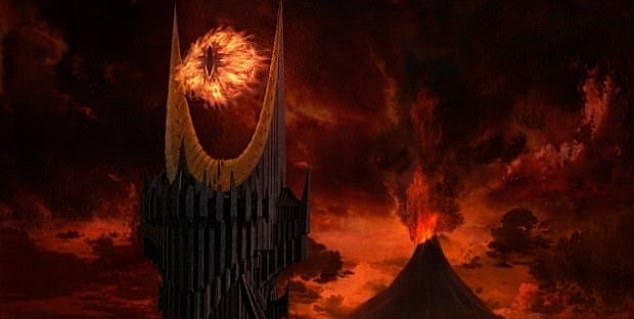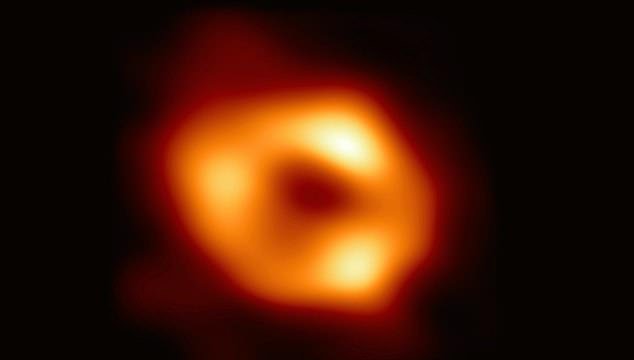New image of supermassive black hole resembles the Eye of Sauron from Lord Of The Rings
Scientists have released an image of the supermassive black hole at the heart of our Milky Way, calling it a “milestone in astronomy.”
More than 300 researchers from Africa, Asia, Europe and the Americas created the stunning photo using the Event Horizon Telescope, which revealed electric orange swirls around the edge of Sagittarius A* (Sgr A*).
Sgr A* has been seen in photos before, but the latest is the first to use polarized light to reveal its magnetic fields – and astronomers said it looks like the Eye of Sauron from JRR Tolkien’s film adaptation of Lord Of The Rings
The team used a specific filter to view the black hole’s magnetic fields, which allowed them to observe strong magnetic fields swirling around the surrounding gas and matter.
The twisting structure of Sgr A* is similar to that of the first and only other black hole photographed, Messier 87 (M87), suggesting that all black holes have strong magnetic fields. – a concept that challenges previous studies.
The new image was captured for the first time using polarized light, using a filter to observe the black hole’s magnetic fields, which showed how it interacts with surrounding gas and matter.

The twisting structure of Sgr A* is similar to that of the first and only other black hole photographed, Messier 87 (pictured), suggesting that all black holes possess strong magnetic fields – a concept that challenges previous studies
Sara Issaoun of Harvard, co-leader of the project, said: ‘What we see now is that there are strong, distorted and organized magnetic fields near the black hole at the center of the Milky Way.
‘Together with the fact that Sgr A* has a strikingly similar polarization structure to that in the much larger and more powerful black hole M87*, we have learned that strong and ordered magnetic fields are critical to the way black holes interact with the gas and the matter surrounding it. them.’
Almost every large galaxy has a supermassive black hole at its center – and ours is Sgr A*.
The monster has four million times the mass of our sun and is located about 26,000 light-years – the distance light travels in a year, 9.9 trillion kilometers – from Earth.
The first image of Sgr A* showed him as a glowing red-orange colored donut hanging in the darkness of space – but the structure was also too blurry to make out details.
But the final work produced a beautiful photo, thank you against polarized light.

Sgr A* has previously been captured by astronomers, but the latest images reveal never-before-seen details similar to the Eye of Sauron (pictured) from the film adaptation of JRR Tolkien’s Lord Of The Rings, astronomers said

The first image of Sgr A* showed him as a glowing red-orange colored donut hanging in the darkness of space – but the structure was also too blurry to make out details
“Light is an oscillating or moving electromagnetic wave that allows us to see objects,” astronomers shared in the announcement.
Sometimes light oscillates in a preferred orientation, and we call it ‘polarized’. Although polarized light surrounds us, it is indistinguishable from ‘normal’ light to the human eye.
‘In the plasma around these black holes, particles that swirl around magnetic field lines create a polarization pattern perpendicular to the field.’
This allows astronomers to see in increasingly vivid detail what’s happening in regions of black holes and map their magnetic field lines.
Harvard Black Hole Initiative Fellow and project leader Angelo Ricarte said: ‘By imaging polarized light from hot glowing gas near black holes, we directly infer the structure and strength of the magnetic fields that drive the flow of gas and matter through lead the black holes. hole is fed and ejected.
‘Polarized light teaches us much more about astrophysics, the properties of the gas and the mechanisms that take place when a black hole feeds.’
To observe Sgr A*, the collaboration connected eight telescopes around the world to create an Earth-sized virtual telescope known as the Event Horizon Telescope.
Although the team had a powerful telescope, as you can imagine, locating a black hole in polarized light is not always an easy task.
They noted that Sgr A* was especially challenged because it is changing so quickly – “it doesn’t sit still for photos,” researchers said.
However, M87 was a much more stable black hole, which is likely why astronomers chose it as the first target ever photographed.
EHT project scientist Geoffrey Bower said: ‘Creating a polarized image is like opening a book after seeing only the cover.
“Because Sgr A* is moving around while we are trying to take the photo, it was difficult to construct even the unpolarized image,” adding that the first image was an average of multiple images due to Sgr A*’s movement.
‘We were relieved that polarized imaging was possible at all. Some models were far too messy and turbulent to construct a polarized image, but nature was not so cruel.’
Scientists say having images of both supermassive black holes in polarized light will open up new methods for comparing and contrasting black holes of different sizes and masses.
And as technology improves, the images will likely reveal even more secrets of black holes and their similarities or differences.
Mariafelicia De Laurentis, EHT Deputy Project Scientist and Professor at the University of Naples Federico II, Italy, said: ‘The fact that the magnetic field structure of M87* is so similar to that of Sgr A* is significant because it suggests that the physical processes that determining how a black hole fuels and launches a jet may be universal among supermassive black holes, despite differences in mass, size, and environment.
‘This result allows us to refine our theoretical models and simulations, improving our understanding of how matter is affected near the event horizon of a black hole.’
The black hole M87 has a mass six billion times that of our sun and is located at the center of a gigantic elliptical galaxy.
It ejects a powerful jet of plasma – a gas so hot that some or all of its atoms are split into the subatomic particles electrons and ions – visible at all wavelengths.
Evidence for a jet flowing out of Sgr A* is mounting, researchers said.
“One thing we’re really excited about is the forecast for a high-performance jet. As our instrumentation improves in the coming years, if it exists, we should be able to extract it from the data,” Ricarte said.
